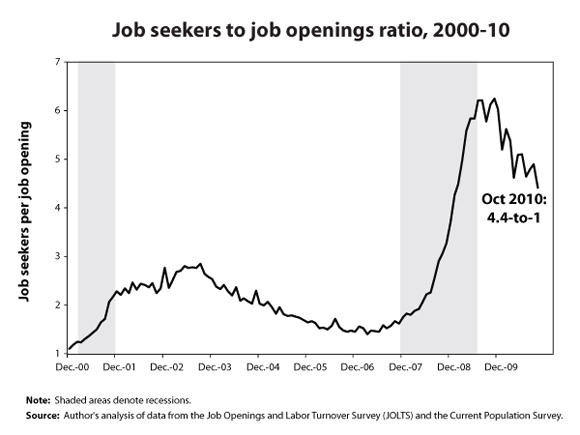This morning, the Bureau of Labor Statistics released a mildly encouraging October report from the Job Openings and Labor Turnover Survey (JOLTS), showing that job openings increased by 351,000 in October, while revisions to earlier data reveal that there were 82,000 more job openings in September than previously reported.
The total number of job openings in October was 3.4 million, while the total number of unemployed workers was 14.8 million (according to the Current Population Survey). This is the highest number of monthly job openings since August 2008. The ratio of unemployed workers to job openings improved to 4.4-to-1 in October, an increase from the revised September ratio of 4.9-to-1. The trend in the job-seekers ratio has been improving over the last few months, but it is important to remember that the current ratio is still over 50% higher than its peak (2.8-to-1) during the early 2000s recession.

It is important to note that the job-seekers ratio does not measure the number of applicants for each job. There may be a mass of applicants for every job posting, since job seekers apply for multiple jobs. Instead, the 4.4-to-1 ratio means that for every 4.4 unemployed workers, there is only one job available—or for about every three out of four unemployed workers, there simply are no jobs. Furthermore, when calculating the ratio of job seekers to job openings, if we were to include not just the 14.8 million unemployed workers, but also the 9.2 million “involuntarily part-time” workers (those who want and are available for a full-time job, and are therefore likely job searching), the ratio would be 7.1-to-1. Although these numbers show some improvement in the labor market in October, the number of unemployed continued to rise by nearly 300,000 in November. Clearly, the labor market has a long way to go before we see anything resembling a recovery.
With so many unemployed workers per available job, it is no surprise that workers who have been laid off continue to get stuck in unemployment for very long periods. In October, 41.8% of this country’s unemployed workers had been jobless for over six months, the maximum amount of time a worker who has been laid off can receive regular state benefits. On November 30th, the federally funded extended unemployment insurance benefits expired. These benefits provide a lifeline to the unemployed and their families during the deepest and longest downturn since the 1930s, while at the same time boosting spending in the economy and therefore generating jobs. The EPI report A Good Deal for All shows that the continuation of unemployment insurance extensions through 2011 will create or save 723,000 full-time-equivalent jobs. With the labor market currently unable to provide jobs for more than three out of four unemployed workers, Congress must seize this opportunity.
— Research assistance by Andrew Green.
